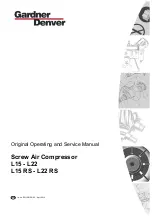
GENERAL INFORMATION
21
D60 D75
D100 D102
Fig. 4
Fig. 3
Fig. 5
SCREW AIREND
1 The airend is a single–stage screw–type compressor cooled by
coolant injection.
Running in its casing (Fig. 4) are two helical rotors, viz. the male
rotor (Fig. 3/1) and the female rotor (Fig. 3/2) with meshing teeth.
Whilst the rotors are in rotating movement, air is taken in at the top
through the intake nozzle (Fig. 3/3).
The spaces, or flutes, between the rotor teeth, or lobes, are
continuously increased on the top side by rotation of the rotors, until
these flutes are opened over their full length and filled with air. The
intake side is closed off by so–called inlet control ledges.
After an air transport phase, the process of compression is started
on the underside. The flutes of the female rotor are continuously
reduced on rotation of the rotors by engagement of the male rotor lobes
in the flutes. This causes the trapped air to be compressed.
2 When reaching the outlet control ledges, the compressed air is
completely discharged through the discharge nozzle (Figs. 3/4 and 5/1)
into the separator (Fig. 5/2).
The rotors have a field–proven and energy–saving asymmetrical
profile.
Whilst compression is in progress, coolant is injected into the
compression chamber. This coolant is designed to absorb the
compression heat, to lubricate the rotors, bearings and gear unit, and
to seal off the gap between the rotors as well as the face–end clearance
between the rotors and the airend casing (there is no metallic contact
and no wear).
The screw–type airend does not have any out of balance forces.
Further, it does not need any intake or discharge valves for control
purposes, and as such warrants quiet and low–wear running of the
machine unit.
In the separator (Fig. 5/2), the coolant is pre–separated from the
compressed air by reduction of the flow velocity along with a change
in the direction of flow (Fig. 5/3). The compressed air then flows above
the coolant level of the coolant sump through a coolant separator
cartridge (Fig. 5/4) to the min. pressure valve (Fig. 5/5). When the air
pressure exceeds a level of 5 bar, the air is discharged to the connected
consumer.
Содержание D100
Страница 2: ......
Страница 15: ...GENERAL INFORMATION 12 D60 D75 D100 D102 ECOCONTROL ECOCONTROL ...
Страница 16: ...GENERAL INFORMATION 13 D60 D75 D100 D102 ECOCONTROL ECOCONTROL ...
Страница 17: ...GENERAL INFORMATION 14 D60 D75 D100 D102 ECOCONTROL U MAX 220V I MAX 8A P MAX 24V 150 WATTS ECOCONTROL ...
Страница 20: ...GENERAL INFORMATION 17 D60 D75 D100 D102 ECOMATIC ECOMATIC ...
Страница 21: ...GENERAL INFORMATION 18 D60 D75 D100 D102 ECOMATIC ECOMATIC ...
Страница 51: ......
Страница 52: ......
Страница 53: ...Printed in the United Kingdom ...
















































